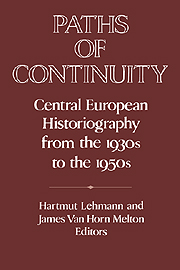Book contents
- Frontmatter
- Introduction: Continuities in German Historical Scholarship, 1933-1960
- 1 German Historiography from the 1930s to the 1950s
- 2 Friedrich Meinecke (1862-1954)
- 3 Change and Continuity in German Historiography from 1933 into the Early 1950s: Gerhard Ritter (1888-1967)
- 4 Hans Rothfels (1891-1976)
- 5 Franz Schnabel (1887-1966)
- 6 Heinrich Ritter von Srbik (1878-1951)
- 7 “Historical Social Science” and Political Myth: Hans Freyer (1887-1969) and the Genealogy of Social History in West Germany
- 8 Some Observations on the Work of Hermann Aubin (1885-1969)
- 9 From Folk History to Structural History: Otto Brunner (1898-1982) and the Radical-Conservative Roots of German Social History
- 10 Werner Conze (1910-1986): The Measure of History and the Historian's Measures
- 11 Continuity, Innovation, and Self-Reflection in Late Historicism: Theodor Schieder (1908-1984)
- Index
3 - Change and Continuity in German Historiography from 1933 into the Early 1950s: Gerhard Ritter (1888-1967)
Published online by Cambridge University Press: 05 January 2013
- Frontmatter
- Introduction: Continuities in German Historical Scholarship, 1933-1960
- 1 German Historiography from the 1930s to the 1950s
- 2 Friedrich Meinecke (1862-1954)
- 3 Change and Continuity in German Historiography from 1933 into the Early 1950s: Gerhard Ritter (1888-1967)
- 4 Hans Rothfels (1891-1976)
- 5 Franz Schnabel (1887-1966)
- 6 Heinrich Ritter von Srbik (1878-1951)
- 7 “Historical Social Science” and Political Myth: Hans Freyer (1887-1969) and the Genealogy of Social History in West Germany
- 8 Some Observations on the Work of Hermann Aubin (1885-1969)
- 9 From Folk History to Structural History: Otto Brunner (1898-1982) and the Radical-Conservative Roots of German Social History
- 10 Werner Conze (1910-1986): The Measure of History and the Historian's Measures
- 11 Continuity, Innovation, and Self-Reflection in Late Historicism: Theodor Schieder (1908-1984)
- Index
Summary
“As a result of my public lectures,” the Freiburg historian Gerhard Ritter wrote on February 11, 1933, “I am planning to write two books. One will be entitled: 'What is Liberalism,' and will be the attempt to pave the way for the founding of a large national party of the center, a party which we need today more than ever before. This book will contribute to the drafting of a new liberal national program, which will offer political orientation based on historical reflection. . . . The second book is to . . . shed light on the great crises in the political and intellectual history of Germany and will thus explain the present state of mind of the German people. This second book will serve two purposes: It will develop a new concept of the history of our nation. . . and it will help deepen the notion of the idea of German nationality and national consciousness after a time during which this idea has in public use become unbearably trivial. New tasks are crowding in upon us. In our era the historian acquires a distinctive national function, an educational function. Certainly, for the time being no one wants to listen to him, because everyone is still running after the noisy political agitators. But I am confident that a time will come when everyone will be thoroughly fed up with the din of national phrase-making and will long for a pure drink instead of the inebriating potion administered by the Nazis. The historian has to prepare positions for the reserves. . . . ”
- Type
- Chapter
- Information
- Paths of ContinuityCentral European Historiography from the 1930s to the 1950s, pp. 83 - 118Publisher: Cambridge University PressPrint publication year: 1994
- 1
- Cited by



